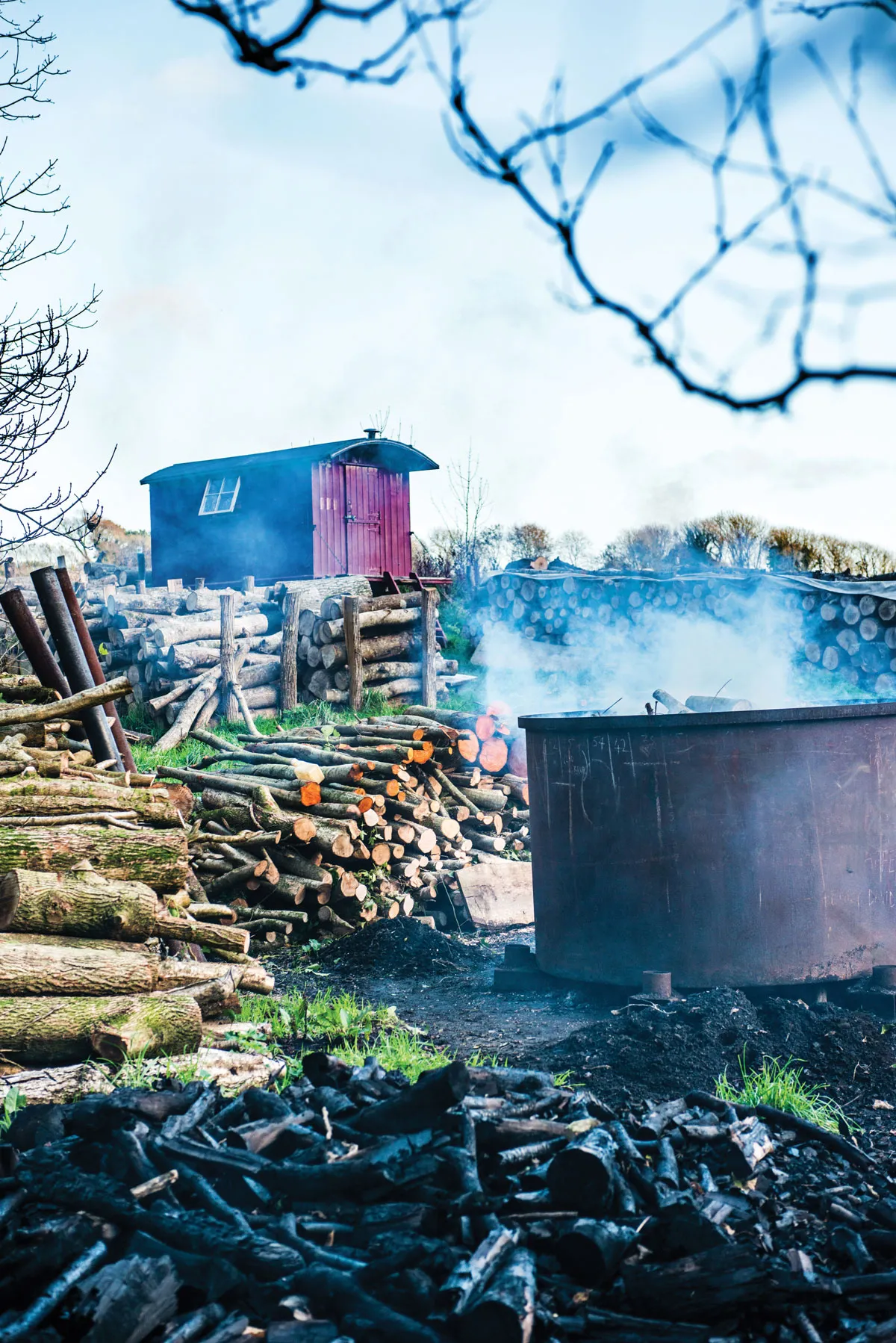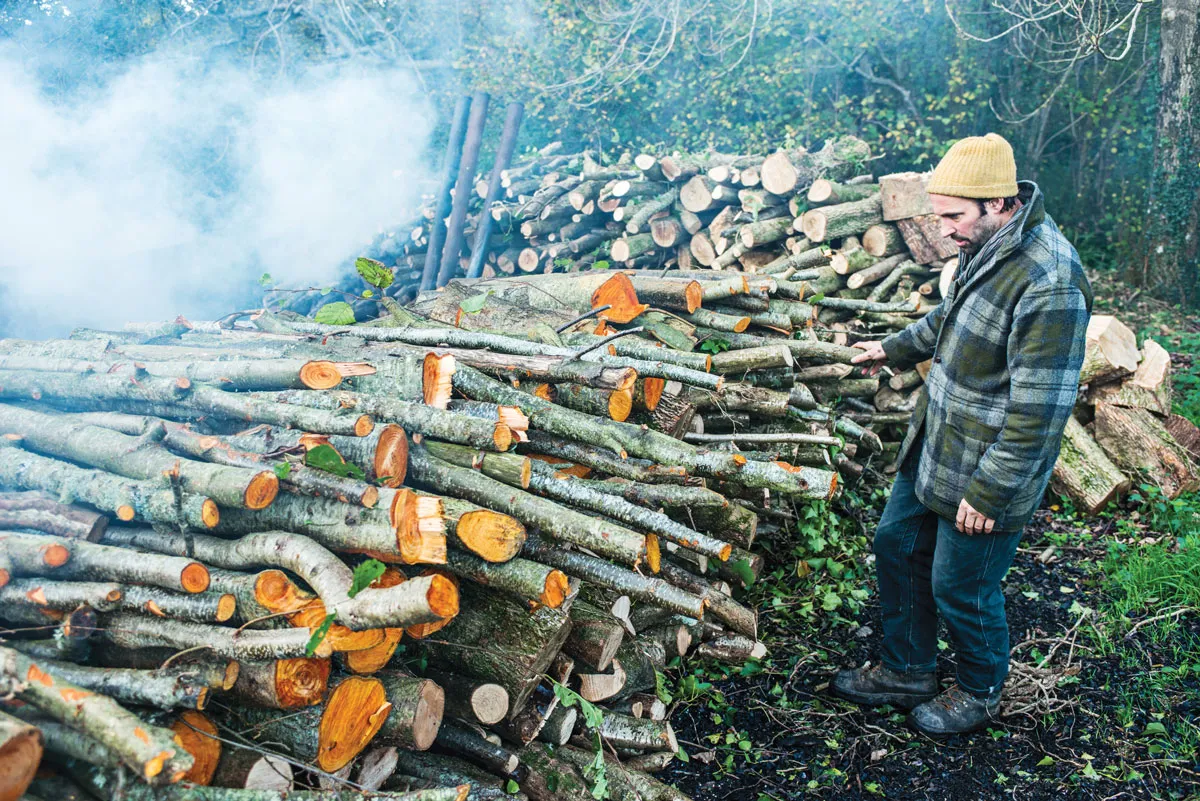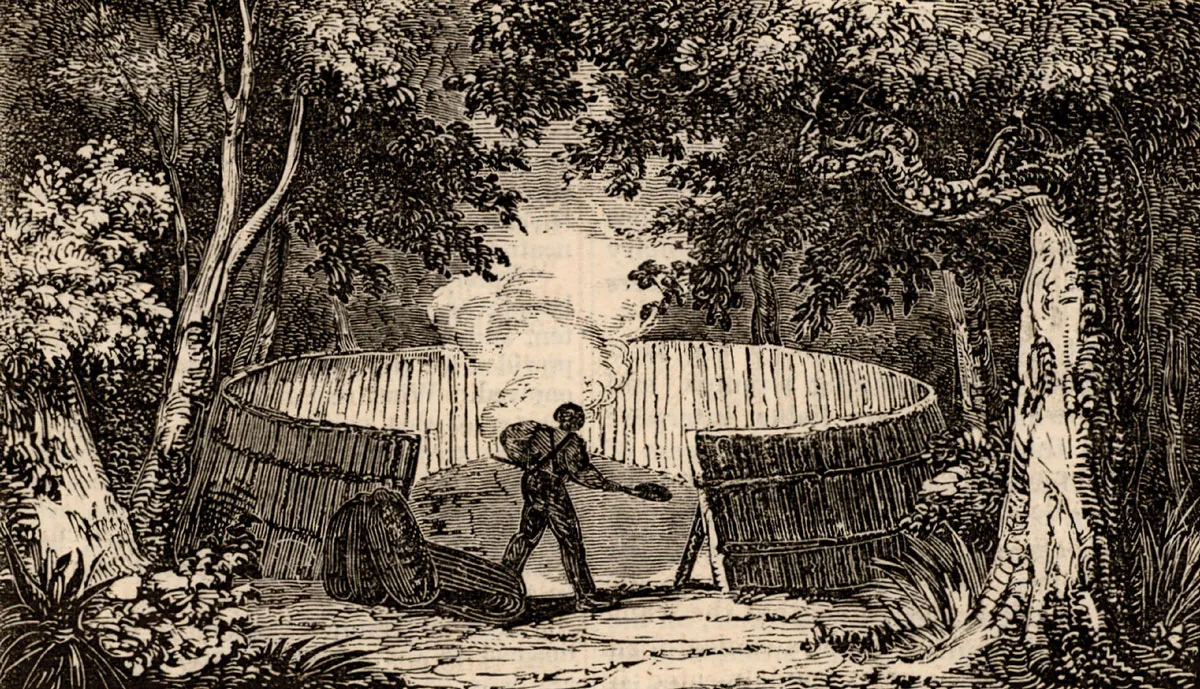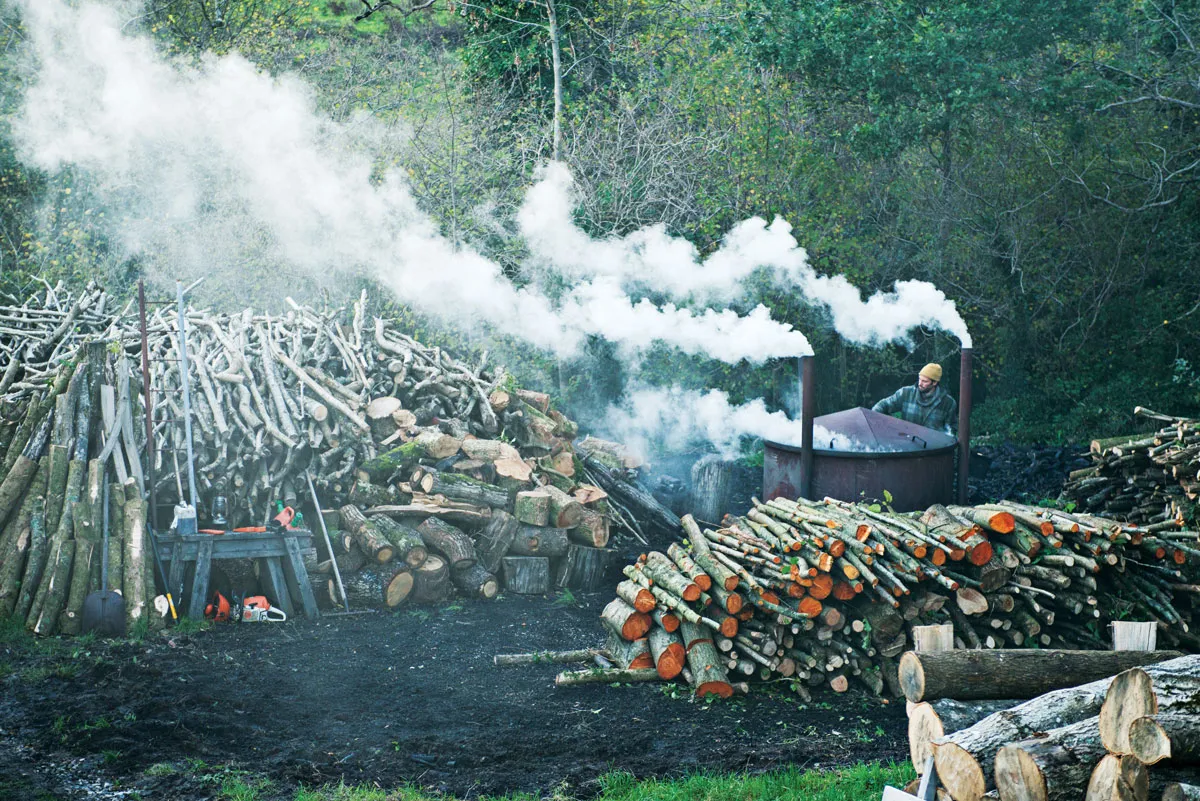In a clearing on the edge of a copse, Ben Short carries his last bundle of hazel towards the kiln. The sun is setting over an Iron Age hill fort and nearby is a neat stack of alder logs, their sawn-off ends glowing burnt-orange like cigars, as if in anticipation of their fate.

“Alder traditionally makes the best charcoal,” explains Ben as he carefully loads the wood into the top of the kiln. “It used to be used in gunpowder because it can be ground down so fine.”
But today, the alder is spared, and the wood filling the one-ton kiln is field maple from the adjoining copse, together with hazel, blackthorn and spindle, off-cuts from hedge-laying work. The good ash is set aside for firewood. Ben lights a petrol-soaked rag on the end of a stick and pushes it into the one of the air ports at the bottom of the kiln. Nothing happens. It’s late autumn – the end of charcoal burning season – the ground is cold and the wood is damp. He lights two more rags, and we wait.

At first, just one chimney smokes, then another. Suddenly Ben disappears like a battlefield soldier into a 30ft column of smoke that obliterates the impressionist landscape around us. It’s toxic stuff. There’s no escaping the plume, which, now that the wind’s picked up, seems to chase us like an angry wasp, no matter what direction we stand in.
“This stage is the free-burn,” explains Ben. “Although I wear a mask, I still wheeze from all these fine particles of dust. That’s the one thing I keep thinking… I enjoy the work but I can’t risk my lungs. I should get an air-flow mask.”
Smoked out
While Ben banks up the kiln’s sides with earth and puts on the steel lid, I flee to a safe distance, eyes streaming, shouting questions into the smog that I doubt he can even hear.
But he does. I learn from Ben’s disembodied voice that he works year-round coppicing, wood-thinning and hedge-laying. He burns charcoal from spring to autumn, packages it and sells it for £6 a bag as barbecue fuel at Bridport market. In his spare time (what little there is), Ben rows, writes and paints, but before all this, he was the creative director of a big London ad-agency.
Eventually, the wind settles and the ad-man turned woodsman re-emerges intact but for a slightly grubby face and black hands. The pastoral landscape pieces itself back together, but my romantic image of the charcoal burner is shattered. It’s clearly hard, dirty work.
“I spend most of the money I make on soap,” laughs Ben. “You don’t want to see my bath when I get out of it. The worst thing is this black eyeliner which lasts for days. People usher their children away from me in supermarkets.”
Now that the water vapour has burnt off, the smoke forms neat, vertical lines. The volatile gases are expelled through the chimneys and the tar will ooze out of the bottom of the kiln.
Finally, the third chimney smokes, and we retire to the 1920s wagon that Ben towed here from North Yorkshire. A glassfibre caravan certainly wouldn’t do, I realise, taking in the symmetry of his workplace. Everything is beautiful on the eye, from the elegantly stacked logs to his hand-drawn illustrations on the charcoal bags. Even Ben’s Swanndri jacket
(a New Zealand brand) garners a compliment from the photographer.
I note the Lavazza coffee (a single nod to his city life), and sit on the woollen army blanket that he sleeps under during summer burns. Tonight, though, Ben will stay in the room he rents from an artist in the village, returning to the kiln at midnight to swap the air vents around, and again at 5am to shut down the kiln. If he oversleeps, and misses the thin blue smoke that indicates the wood has carbonised, the charcoal itself will burn, along with all his profits.
Profits, which Ben admits, are a long way off the near three-figure salary he’d become accustomed to in London. Back then he was travelling overseas, copy-writing and shooting commercials, but he was also “deeply unhappy”.
Fired up with enthusiasm
“Ironically, despite its title, my job was bereft of creativity. It just didn’t feel fulfilling. One day I felt I’d had enough, I didn’t know what to do, but I knew it couldn’t be that life,” he recalls.
After a stint working for the National Trust in Cambridge, Ben moved to west Dorset where his brother lived. “I didn’t feel I had anywhere else to go. When you walk away from a life it’s exciting, but scary, too. I had no transferable skills.”
So he found work as a labourer before becoming an apprentice on an agro-forestry project, where he learnt to coppice overstood woodland. It’s a job he’s still doing today, only he works for himself now. “There are thousands of acres of derelict coppice in this country, but unless you are getting paid for the job – and not just working for the value of the wood alone – it’s just not economical to cut it,” explains Ben.
“The stools [tree stumps] grow, and the canopy closes above them, preventing light from reaching the forest floor and limiting the biodiversity. It’s a shame, because a coppiced wood is a much happier wood, where bluebells, violets and wood anemone grow, and you get dormice and fritillary butterflies.”
The wood we’re sitting in today belongs to a local landowner who is employing Ben to thin it. It has been left for 60 years, so will keep Ben busy for the foreseeable future. Outside the wagon it’s pitch black, and the burn is well under way, creating charcoal for the Easter markets. By spring Ben will be busy cutting wood and burning charcoal for summer trade, having spent the winter hard at work hedge-laying.
His life is simple and cyclical, but does he get lonely, I wonder, working long days by himself and returning in the dead of night?
“Sometimes,” he admits. “Not so much these days.” He hesitates. “I don’t want to go all hippyish on you, but I feel I have company all around me in the woods.”
The wildlife? After all, he encounters fallow deer, buzzards and even the occasional adder seeking warmth in the woodpile. “Yes that, but also just the energies in the woods and the fields. I feel it. I did when I was a boy, too, growing up on a remote Hampshire smallholding.”

Ben plays an active role in village life, which must keep loneliness at bay. Chalked on the side of his kiln, alongside literary quotes, is a list of names for next season’s gig-rowing team. “Don’t publish those, or I’ll get in trouble,” he laughs.He also does bell-ringing on a Sunday and has breakfast every Thursday with fellow villagers.
“Really, I feel that my life is full now. If I could do more writing and painting that would be great, but as far as material things go, or anything else…” he tapers off. “I’m happy.”
I can see Ben enjoys life as a hedge-layer and charcoal burner, but is there anything he misses about his old life? “Well, there is one thing,” he concedes after great thought. “I wouldn’t mind going skiing once in a while.” Then, with a shrug, he returns to check the progress of his burn.
Charcoal burning: an ancient trade

Ben first came across charcoal burners as a child, and it’s a memory that’s never left him. “It was 1978, and our headmaster took us to a woodland on the Hampshire Downs. I remember seeing the kilns smoking and the men in tatty clothes cutting wood. It was very atmospheric; beautiful light. I was drawn to them.”
Even in the 1970s, this would have been a rare sight, as charcoal burning was a dying craft in the UK. Today, Ben estimates there are only around 250 charcoal burners left in the UK. For over 3,000 years, people burnt charcoal to create fuel for iron-smelting, glass-making and working precious metals, but with an increase in coal from the 18th century, the industry went into decline.
The First World War saw a brief revival as activated charcoal was used in gas masks to absorb molecules of gas. But after the war it came to an abrupt end.
It was a lonely life, and a poorly regarded profession. In an account by a 19th-century New Forest inspector, charcoal burners were said to be “not generally the most reputable people”, due to the craft encouraging the theft of cord wood for use in the earth kilns.Even in the 17th century, William III forbade colliers from making charcoal in the New Forest, with offenders liable for a £100 fine. In the Middle Ages, charcoal burners were ostracised, which Ben believes is down to the time they spent in the woods.
“By the nature of their work, charcoal burners had to live away from society. The rural taste for superstition is well documented and a mythology grew around them,” he explains.
Getting started

Ben’s transition into charcoal burning came about after a conversation with a traditional boat builder, Gail McGarva, who he met through his gig-rowing team. Gail had received funding from QEST (Queen Elizabeth Scholarship Trust), a charity that provides financial and practical support to more than 350 craftspeople across 130 different skill sectors. She suggested Ben apply, too. Ben followed Gail’s advice and was invited to pitch to a 12-strong panel in London. “I was so nervous,” recalls Ben, “but it was less of a presentation and more a conversation across the table. The chairman Nick Farrow was brilliant. He made it easy for me.”
Ben was successful and thanks to funding from QEST was able to give up part-time labouring and concentrate full-time on coppicing, coppice restoration and charcoal burning. Several years later, with his own kiln on the side of an overstood woodland, he’s never been happier.
“I’m not a great fan of modernity; how we’re forced into little boxes and our lives are shaped,” he says. “When I got away from that, something chimed in me. It’s good to be useful, be physical, to try and live a creative life in the biggest sense of the word.”
QEST considers applications for apprenticeships in the autumn, while applications for scholarships are awarded in the spring. www.qest.org.uk

